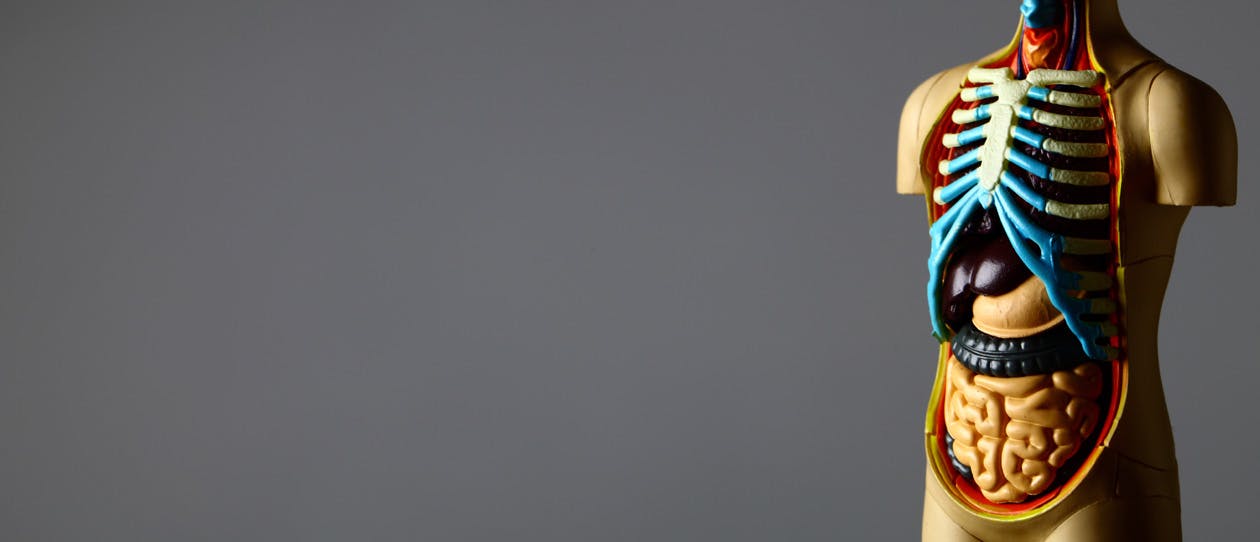A
Abdominal aorta
The largest artery in the abdominal cavity. It is a continuation of the upper part of the aorta, which exits directly from the heart.
Amylase
An enzyme that breaks down carbohydrates. Secreted from the
pancreas and the salivary glands.
Appendix (Vermiform appendix)
A small blind-ended tube attached near the junction of the small and
large intestines. Vermiform means 'worm-shaped,' as it has been likened to a worm in appearance.
B
Bile
A fluid secreted by the liver to aid the mechanical breakdown of fats.
Bolus
A lump of food that has been mixed with saliva and is ready to be swallowed.
Buccal cavity
The part of the mouth between the teeth and the cheeks.
C
Caecum
The first section of the large intestine.
Chemical digestion
The breaking down of foods into smaller components by enzymes.
D
Duodenum
First section of the small intestine. Food contents leave the stomach and are mixed with digestive enzymes from the pancreas and bile. Nutrient digestion begins here.
E
Enzymes
Proteins or protein-based molecules that speed up chemical reactions in the body.
Epiglottis
A structure made of cartilage that blocks off the trachea (wind pipe) while swallowing.
F
Flatus
Gas generated in the digestive tract as the body breaks down food.
G
Gallbladder
A sack-like structure that stores and concentrates bile.
Gastric juice
A colourless, highly acidic liquid secreted in the stomach that contains hydrochloric acid and other substances to aid digestion.
H
Hepatic Portal Vein
A vein that carries blood from parts of the gastrointestinal tract to the
liver. After the small intestine absorbs nutrients, they travel to the liver via this vein to be processed.
Hydrochloric acid
Highly acidic solution of hydrogen chloride secreted by the stomach. It is a component of gastric juice.
I
Ileum
final and longest portion of the small intestine. It is about 4 metres long and is the site of vitamin B12 absorption.
Intrinsic factor
A substance produced in the stomach that is necessary for the absorption of vitamin B12 in the small intestines.
J
Jejunum
The middle section of the small intestine. The ancient Greeks noticed that when we die it is always empty of any food; so the name jejunum comes from a Latin word for 'empty of food' or 'hungry'.
L
Lipase
A fat-digesting enzyme released into the small intestine by the pancreas.
M
Mastication
Chewing.
Masseter muscle
The prominent muscle of the jaw. It is responsible for closing the jaw when chewing.
Mechanical digestion
Involves mechanically breaking down food (eg chewing), to prepare it for chemical digestion.
Mesentery
A layer of membranes that provide a route for blood vessels, lymphatic vessels and nerves to reach the digestive organs. Mesenteries also hold organs in place.
O
Oesophagus
An approximately 25 cm long muscular tube that is also called the swallowing tube. It joins the mouth with the stomach and is lined with mucus to keep it oist.
P
Palate
The roof of the mouth consisting of a hard palate at the front (which is underlain by bone), and the soft palate at the back (which is soft and fleshy).
Pancreas
An abdominal organ which excretes pancreatic juice containing enzymes for chemical digestion into the duodenum.
Parotid gland
A salivary gland that sits in front of the ears between the masseter muscle and the skin. It empties saliva into the mouth.
Peristalsis
Alternate waves of propulsion and contraction by the smooth muscle in the walls of organs including the digestive tract.
Proteases
Enzymes that digest proteins.
Pyloric Sphincter
A muscular gate that controls the emptying of the stomach into the duodenum.
Pepsin
A protein-digesting enzyme secreted in the stomach.
R
Rectum
The last part of the large intestines, which ends at the anus.
S
Saliva
A fluid made up of mostly water that also contains digestive enzymes (salivary amylase) and natural anti-bacterial agents.
Splanchnic circulation
Arteries that branch off the abdominal aorta to provide blood to the digestive organs.
Sublingual gland
A small salivary gland that sits under the tongue and empties saliva into the mouth via 8 to 20 ducts that empty into the floor of the mouth.
Submandibular gland
A salivary gland that sits under the bottom jaw and empties saliva into the front of the mouth under the tongue. It produces most of our nocturnal saliva.
T
Trypsin
A protein-digesting enzyme (protease) secreted by the pancreas.
U
Uvula
The tear shaped fleshy projection hanging down from the soft palate in the mouth. It helps to stop food from going down the wrong way (down the breathing passages), and is one of the structures thought to be involved in snoring.
V
Villi
Finger-like projections on the lining of the small intestine that increase the surface area for better absorption of nutrients.
References available on request


